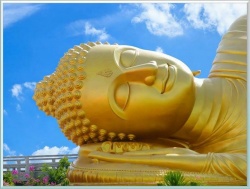Difference between revisions of "Madhyamika svatantrika"
| (2 intermediate revisions by the same user not shown) | |||
| Line 1: | Line 1: | ||
[[File:1900ki.jpg|thumb|250px|]] | [[File:1900ki.jpg|thumb|250px|]] | ||
<poem> | <poem> | ||
| − | (skt.: [[madhyamika svatantrika]]; tib.: [[uma rang gyu pa]]) A system analysing [[emptiness]] founded by [[Bhavaviveka]] (500-578) which is considered as a lower part of [[Madhyamika]]. [[Madhyamika Svatantrika]] makes a {{Wiki|distinction}} between the [[true existence]] of [[phenomena]] and the [[inherent]] [[existence]] of [[phenomena]]. They say that things do [[exist]] inherently, from their own side, but that they do not [[exist]] truly. Their explanation for this {{Wiki|distinction}} is that things [[exist]] from their own side (inherently) as well as being posited by [[thought]], {{Wiki|concept}}. | + | (skt.: [[madhyamika svatantrika]]; tib.: [[uma rang gyu pa]]) A system analysing [[emptiness]] founded by [[Bhavaviveka]] (500-578) which is considered as a lower part of [[Madhyamika]]. [[Madhyamika Svatantrika]] makes a {{Wiki|distinction}} between the [[true existence]] of [[phenomena]] and the [[inherent]] [[existence]] of [[phenomena]]. They say that things do [[exist]] inherently, from their [[own]] side, but that they do not [[exist]] truly. Their explanation for this {{Wiki|distinction}} is that things [[exist]] from their [[own]] side (inherently) as well as being posited by [[thought]], {{Wiki|concept}}. |
According to them, a [[phenomenon]] [[exists]] in depedence of (both must be {{Wiki|present}}): | According to them, a [[phenomenon]] [[exists]] in depedence of (both must be {{Wiki|present}}): | ||
| − | 1. [[existence]] from its own side and | + | 1. [[existence]] from its [[own]] side and |
2. of the [[mental]] [[thought]] [[imputed]] onto it | 2. of the [[mental]] [[thought]] [[imputed]] onto it | ||
| − | |||
'''[[Svatantrika]]''' (Skt. ''[[Svātantrika]]''; Tib. {{BigTibetan|[[རང་རྒྱུད་པ་]]}}, [[Wyl.]] ''[[rang rgyud pa]]''), '[[Autonomous Syllogism]]' — a subschool of [[Madhyamika]] inaugurated by [[Bhavaviveka]] in his commentary upon [[Nagarjuna]]'s ''[[Root Verses of the Wisdom of the Middle Way]]''. | '''[[Svatantrika]]''' (Skt. ''[[Svātantrika]]''; Tib. {{BigTibetan|[[རང་རྒྱུད་པ་]]}}, [[Wyl.]] ''[[rang rgyud pa]]''), '[[Autonomous Syllogism]]' — a subschool of [[Madhyamika]] inaugurated by [[Bhavaviveka]] in his commentary upon [[Nagarjuna]]'s ''[[Root Verses of the Wisdom of the Middle Way]]''. | ||
| Line 19: | Line 18: | ||
==Subschools== | ==Subschools== | ||
| − | The [[Svatantrikas]] are divided into '''early''' and '''later''': [[Acharya]] [[Shrigupta]] belongs to the earlier; [[Jñanagarbha]], [[Shantarakshita]] and [[Kamalashila]], the so-called | + | The [[Svatantrikas]] are divided into '''early''' and '''later''': [[Acharya]] [[Shrigupta]] belongs to the earlier; [[Jñanagarbha]], [[Shantarakshita]] and [[Kamalashila]], the so-called ‘[[Three Eastern Khenpos]]’ belong to the later. |
| − | In addition, [[Bhavaviveka]] is said to belong to the '''[[Sautrantika Svantantrika]]''', [[Shrigupta]] to the [[tradition]] of the '''[[Svatantrika]] of {{Wiki|distinct}} [[appearance]] and [[emptiness]]''', [[Jñanagarbha]], [[Shantarakshita]] and [[Kamalashila]] to the [[tradition]] of the '''[[Yogachara]] [[Svatantrika]]''', and [[Acharya]] [[Sagaramegha]] to the [[tradition]] of '''[[Svatantrika]] of [[Logical]] [[Illusion]]'''. | + | In addition, [[Bhavaviveka]] is said to belong to the '''[[Sautrantika]] [[Svantantrika]]''', [[Shrigupta]] to the [[tradition]] of the '''[[Svatantrika]] of {{Wiki|distinct}} [[appearance]] and [[emptiness]]''', [[Jñanagarbha]], [[Shantarakshita]] and [[Kamalashila]] to the [[tradition]] of the '''[[Yogachara]] [[Svatantrika]]''', and [[Acharya]] [[Sagaramegha]] to the [[tradition]] of '''[[Svatantrika]] of [[Logical]] [[Illusion]]'''. |
==Notes== | ==Notes== | ||
Latest revision as of 20:27, 18 March 2015
(skt.: madhyamika svatantrika; tib.: uma rang gyu pa) A system analysing emptiness founded by Bhavaviveka (500-578) which is considered as a lower part of Madhyamika. Madhyamika Svatantrika makes a distinction between the true existence of phenomena and the inherent existence of phenomena. They say that things do exist inherently, from their own side, but that they do not exist truly. Their explanation for this distinction is that things exist from their own side (inherently) as well as being posited by thought, concept.
According to them, a phenomenon exists in depedence of (both must be present):
1. existence from its own side and
2. of the mental thought imputed onto it
Svatantrika (Skt. Svātantrika; Tib. རང་རྒྱུད་པ་, Wyl. rang rgyud pa), 'Autonomous Syllogism' — a subschool of Madhyamika inaugurated by Bhavaviveka in his commentary upon Nagarjuna's Root Verses of the Wisdom of the Middle Way.
==Definition==
In the Nyingma tradition of Mipham Rinpoche, the Svatantrika are defined as "followers of the Madhyamika who teach by emphasizing the categorized absolute involving assertions".[1]
==Tenets==
According to the Svatantrikas, there are two kinds of relative truth: the correct and the incorrect. Correct relative truth refers to phenomena that are undeceiving in terms of their characteristics, i.e. able to perform their particular function. For example, fire, which is hot and burning. The incorrect relative includes phenomena which appear yet do not function as they appear, such as the moon’s reflection or a drawing of a lamp.
The Svatantrikas divide the absolute truth into the conceptual and non-conceptual.
==Subschools==
The Svatantrikas are divided into early and later: Acharya Shrigupta belongs to the earlier; Jñanagarbha, Shantarakshita and Kamalashila, the so-called ‘Three Eastern Khenpos’ belong to the later.
In addition, Bhavaviveka is said to belong to the Sautrantika Svantantrika, Shrigupta to the tradition of the Svatantrika of distinct appearance and emptiness, Jñanagarbha, Shantarakshita and Kamalashila to the tradition of the Yogachara Svatantrika, and Acharya Sagaramegha to the tradition of Svatantrika of Logical Illusion.
==Notes==
==Further Reading==
- The Svatantrika-Prasangika Distinction—what difference does a difference make?, edited by Georges B.J. Dreyfus and Sara L. McClintock (Boston: Wisdom Publications, 2005).
